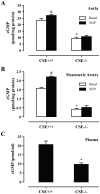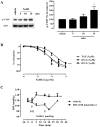cGMP-dependent protein kinase contributes to hydrogen sulfide-stimulated vasorelaxation
- PMID: 23285278
- PMCID: PMC3532056
- DOI: 10.1371/journal.pone.0053319
cGMP-dependent protein kinase contributes to hydrogen sulfide-stimulated vasorelaxation
Abstract
A growing body of evidence suggests that hydrogen sulfide (H₂S) is a signaling molecule in mammalian cells. In the cardiovascular system, H₂S enhances vasodilation and angiogenesis. H₂S-induced vasodilation is hypothesized to occur through ATP-sensitive potassium channels (K(ATP)); however, we recently demonstrated that it also increases cGMP levels in tissues. Herein, we studied the involvement of cGMP-dependent protein kinase-I in H₂S-induced vasorelaxation. The effect of H₂S on vessel tone was studied in phenylephrine-contracted aortic rings with or without endothelium. cGMP levels were determined in cultured cells or isolated vessel by enzyme immunoassay. Pretreatment of aortic rings with sildenafil attenuated NaHS-induced relaxation, confirming previous findings that H₂S is a phosphodiesterase inhibitor. In addition, vascular tissue levels of cGMP in cystathionine gamma lyase knockouts were lower than those in wild-type control mice. Treatment of aortic rings with NaHS, a fast releasing H₂S donor, enhanced phosphorylation of vasodilator-stimulated phosphoprotein in a time-dependent manner, suggesting that cGMP-dependent protein kinase (PKG) is activated after exposure to H₂S. Incubation of aortic rings with a PKG-I inhibitor (DT-2) attenuated NaHS-stimulated relaxation. Interestingly, vasodilatory responses to a slowly releasing H₂S donor (GYY 4137) were unaffected by DT-2, suggesting that this donor dilates mouse aorta through PKG-independent pathways. Dilatory responses to NaHS and L-cysteine (a substrate for H₂S production) were reduced in vessels of PKG-I knockout mice (PKG-I⁻/⁻). Moreover, glibenclamide inhibited NaHS-induced vasorelaxation in vessels from wild-type animals, but not PKG-I⁻/⁻, suggesting that there is a cross-talk between K(ATP) and PKG. Our results confirm the role of cGMP in the vascular responses to NaHS and demonstrate that genetic deletion of PKG-I attenuates NaHS and L-cysteine-stimulated vasodilation.
Conflict of interest statement
Figures






References
-
- Wang R (2002) Two's company, three's a crowd – Can H2S be the third endogenous gaseous transmitter? FASEB J 16: 1792–1798. - PubMed
-
- Sessa W (2004) eNOS at a glance. J Cell Sci 117: 2427–2429. - PubMed
-
- Motterlini R, Otterbein L (2010) The therapeutic potential of carbon monoxide. Nat Rev Drug Discov 9: 728–743. - PubMed
-
- Szabó C (2007) Hydrogen sulphide and its therapeutic potential. Nat Rev Drug Discov 6: 917–935. - PubMed
Publication types
MeSH terms
Substances
LinkOut - more resources
Full Text Sources
Molecular Biology Databases

